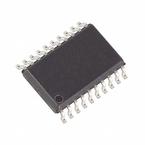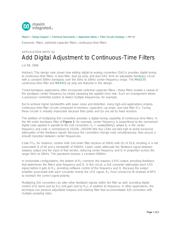herunterladen

Maxim > Design Support > Technical Documents > Application Notes > Filter Circuits (Analog) > APP 63
Keywords: filters, switched-capacitor filters, continuous-time filters
APPLICATION NOTE 63
Add Digital Adjustment to Continuous-Time Filters
Jul 09, 1998
Abstract: This design note shows how adding digital-to-analog converters (DACs) provides digital tuning
to continuous-time filters. A dual filter, dual op amp, and dual DAC form an adjustable bandpass circuit
with a constant 500Hz bandpass over the 5kHz to 20kHz center-frequency range. The MAX275
continuous-time filter and MAX412 op amp are featured in this design.
Tuned-bandpass applications often incorporate switched-capacitor filters—these filters enable a sweep of
the bandpass center frequency by simply sweeping the applied clock rate. Such an arrangement allows
a processor-controlled system to detect multiple frequencies, for example.
But to achieve higher bandwidths with lower noise and distortion, many high-end applications employ
continuous-time filter circuits composed of resistors, capacitors, op amps, and new filter ICs. Tuning
these circuits is virtually impossible because their poles and Qs are set by fixed resistors.
The addition of multiplying D/A converters provides a digital-tuning capability of continuous-time filters. In
the 4th-order bandpass filter of Figure 1, for example, center frequency is proportional to the normalized
digital code applied in parallel to the D/A converters: f
C
= √code(20kHz), where f
C
is the center
frequency and code is normalized to 15/256...255/256 (the four LSBs are tied high to avoid excessive
attenuation of the feedback signal). Because the converters change code simultaneously, they assure a
smooth transition between center frequencies.
Code FF
H
, for instance, centers both 2nd-order filter sections at 20kHz with Qs of 25.8, resulting in a net
(cascaded) Q of 40 and a bandwidth of 500kHz. Lower codes attenuate the feedback signal between
lowpass output and the input of that section, reducing center frequency and Q in proportion across the
range 5kHz to 20kHz. The passband remains a constant 500kHz.
In nontunable configurations, the bottom of R
2
connects the lowpass (LPO) output, providing feedback
that determines the filter's pole frequency and Q. In this circuit, a D/A converter attenuates each LPO
signal before it gets to R
2
, providing software control of the frequency and Q. Because the output
amplifier associated with each converter inverts the LPO signal, R
2
must connect to IN (instead of BPI)
to maintain the correct signal polarity.
Multiplying D/A converters can alter other feedback signals within the filter as well, providing digital
control of Q alone (set by R
3
) and gain (set by R
1
), in addition to frequency. In other applications, the
technique can produce adjustable-lowpass anti-aliasing filter that accommodates A/D converters with
multiple sampling rates.
Page 1 of 2




